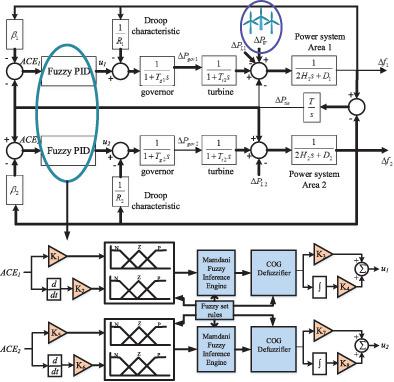当前位置:
X-MOL 学术
›
Int. Trans. Electr. Energy Syst.
›
论文详情
Our official English website, www.x-mol.net, welcomes your
feedback! (Note: you will need to create a separate account there.)
Improving frequency regulation of wind‐integrated multi‐area systems using LFA‐fuzzy PID control
International Transactions on Electrical Energy Systems ( IF 1.9 ) Pub Date : 2021-01-24 , DOI: 10.1002/2050-7038.12802 Mostafa Kheshti 1 , Lei Ding 1 , Hossein Askarian‐Abyaneh 2 , Arvind R. Singh 1 , Saeed Zare 3 , Vladimir Terzija 1
International Transactions on Electrical Energy Systems ( IF 1.9 ) Pub Date : 2021-01-24 , DOI: 10.1002/2050-7038.12802 Mostafa Kheshti 1 , Lei Ding 1 , Hossein Askarian‐Abyaneh 2 , Arvind R. Singh 1 , Saeed Zare 3 , Vladimir Terzija 1
Affiliation

|
Due to the complexity and importance of the electricity grid stability, sophisticated control systems and computational approaches are essentially required to solve dynamical system frequency problems in multi‐area systems. Participation of wind turbines in power system frequency control in the form of stepwise inertial control in the presence of a proposed adequately tuned fuzzy‐PID load‐frequency control is investigated in this paper. A two‐area power system is studied in which it is linked through tie‐line and equipped with fuzzy‐PID control systems. To increase the energy transition and flexibility of the entire system against frequency events and parameters uncertainties, the fuzzy‐PID controllers are first tuned using lightning flash algorithm (LFA). The tuned controllers are then used in each area to optimally counterbalance the frequency deviations and the tie‐line power of the interconnected areas against varying load disturbances, wind power fluctuations, and to keep the renewable integrated system in a stable state. The sensitivity analysis is also conducted with a wide range of system parameter variations, uncertainties, and disturbances. Furthermore, the LFA‐tuned fuzzy‐PID load‐frequency control is also tested in a two‐area isolated microgrid, comprising wind turbine, PV panels, fuel cells, micro‐turbine, and diesel engine generator. The results obtained using the proposed approach are compared with other state‐of‐the‐arts algorithms and control systems in the literature. The compared results show the efficiency and robustness of the proposed optimization‐based controller for better frequency control in multi‐area power systems and isolated microgrids. The results also demonstrate that a finely tuned automatic generation controller gives a significant boost to grid frequency control when wind turbines participate in the inertial control, suggesting migration from conventional PID‐based automatic generation control to more adaptive control approaches.
中文翻译:

使用LFA模糊PID控制改善风能集成多区域系统的频率调节
由于电网稳定性的复杂性和重要性,解决多区域系统中的动态系统频率问题基本上需要复杂的控制系统和计算方法。本文研究了风力涡轮机以逐步惯性控制的形式参与电力系统频率控制的问题,并提出了一种经过适当调整的模糊PID负载频率控制方法。研究了一种两区电力系统,该系统通过联络线链接并配备了模糊PID控制系统。为了提高整个系统的能量转换能力和灵活性,以应对频率事件和参数不确定性,首先使用闪电算法(LFA)对Fuzzy-PID控制器进行调整。然后在每个区域中使用经过调整的控制器,以最佳地平衡互连区域的频率偏差和联络线功率,以抵抗变化的负载干扰,风能波动,并使可再生集成系统保持稳定状态。灵敏度分析还可以进行各种系统参数变化,不确定性和干扰的分析。此外,LFA调整的模糊PID负载频率控制也在两个区域隔离的微电网中进行了测试,包括风力涡轮机,光伏板,燃料电池,微型涡轮机和柴油发动机发电机。使用建议的方法获得的结果与文献中的其他最新算法和控制系统进行了比较。比较结果表明,所提出的基于优化的控制器在多区域电力系统和隔离的微电网中实现更好的频率控制的效率和鲁棒性。结果还表明,当风力涡轮机参与惯性控制时,经过微调的自动发电控制器可显着提高电网频率控制,这表明从传统的基于PID的自动发电控制向更自适应的控制方法过渡。
更新日期:2021-03-02
中文翻译:

使用LFA模糊PID控制改善风能集成多区域系统的频率调节
由于电网稳定性的复杂性和重要性,解决多区域系统中的动态系统频率问题基本上需要复杂的控制系统和计算方法。本文研究了风力涡轮机以逐步惯性控制的形式参与电力系统频率控制的问题,并提出了一种经过适当调整的模糊PID负载频率控制方法。研究了一种两区电力系统,该系统通过联络线链接并配备了模糊PID控制系统。为了提高整个系统的能量转换能力和灵活性,以应对频率事件和参数不确定性,首先使用闪电算法(LFA)对Fuzzy-PID控制器进行调整。然后在每个区域中使用经过调整的控制器,以最佳地平衡互连区域的频率偏差和联络线功率,以抵抗变化的负载干扰,风能波动,并使可再生集成系统保持稳定状态。灵敏度分析还可以进行各种系统参数变化,不确定性和干扰的分析。此外,LFA调整的模糊PID负载频率控制也在两个区域隔离的微电网中进行了测试,包括风力涡轮机,光伏板,燃料电池,微型涡轮机和柴油发动机发电机。使用建议的方法获得的结果与文献中的其他最新算法和控制系统进行了比较。比较结果表明,所提出的基于优化的控制器在多区域电力系统和隔离的微电网中实现更好的频率控制的效率和鲁棒性。结果还表明,当风力涡轮机参与惯性控制时,经过微调的自动发电控制器可显着提高电网频率控制,这表明从传统的基于PID的自动发电控制向更自适应的控制方法过渡。











































 京公网安备 11010802027423号
京公网安备 11010802027423号